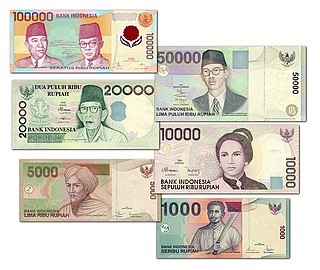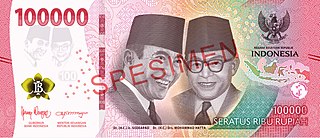
The Malaysian ringgit is the currency of Malaysia. It is divided into 100 sen. The ringgit is issued by the Central Bank of Malaysia.

The rupiah is the official currency of Indonesia, issued and controlled by Bank Indonesia. Its name is derived from the Sanskrit word for silver, rupyakam (रूप्यकम्). Sometimes, Indonesians also informally use the word perak in referring to rupiah in coins. The rupiah is divided into 100 cents, although high inflation has rendered all coins and banknotes denominated in cents obsolete.

The lira was the currency of Italy between 1861 and 2002. It was introduced by the Napoleonic Kingdom of Italy in 1807 at par with the French franc, and was subsequently adopted by the different states that would eventually form the Kingdom of Italy in 1861. It was subdivided into 100 centesimi, which means "hundredths" or "cents". The lira was also the currency of the Albanian Kingdom from 1941 to 1943.

The Netherlands Indies guilder was the unit of account of the Dutch East Indies from 1602 under the United East India Company, following Dutch practice first adopted in the 15th century. A variety of Dutch, Spanish and Asian coins were in official and common usage. After the collapse of the VOC at the end of the 18th century, control of the islands reverted to the Dutch government, which issued silver 'Netherlands Indies' guilder and fractional silver and copper coins until Indonesian independence in 1945.
The West Irian rupiah was a distinct currency of West Irian between 1963 and 1973. It replaced the West New Guinea gulden at par and was replaced by the Indonesian rupiah at the rate of 1 West Irian rupiah = 18.9 Indonesian rupiah.
The pound was the currency of the Australian Territory of New Guinea between 1915 and 1966, and replaced the New Guinean mark when Australia occupied the former German colony at the end of World War I. The New Guinean pound was subdivided into 20 shillings, each of 12 pence, and was equal to the Australian pound.

The Swiss franc has been the currency of Liechtenstein since 1920. The Swiss franc is legal tender since Liechtenstein is in a customs and monetary union with Switzerland. The 1980 treaty between Switzerland and Liechtenstein allows Liechtenstein to mint limited amounts of Swiss francs with a Liechtenstein inscription, but only in the form of commemorative coins, and they are not allowed to issue banknotes.

The first coins of the Indonesian rupiah were issued in 1951 and 1952, a year or so later than the first Indonesian rupiah banknotes printed, following the peace treaty with the Netherlands in November 1949. Although revolutionary currency had been issued by the provisional Indonesian government between 1945 and 1949, it had all been formed of paper, for metal were too scarce for the internationally isolated government to use as currency.

The first banknotes used in the archipelago that would become Indonesia were those issued by the United East India Company, credit letters of the rijksdaalder dating between 1783 and 1811. Netherlands Indies gulden government credit paper followed in 1815, and from 1827 to 1842 and again from 1866 to 1948 gulden notes of De Javasche Bank. Lower denominations were issued by the government in 1919–1920 and in 1939–1940 due to wartime metal shortages, but otherwise day-to-day transactions were conducted using coinage.

The currency of Indonesia, the rupiah, has a long history dating back to its colonial period. Due to periods of economic uncertainty and high inflation, the currency has been re-valued several times.

Idham Chalid was an Indonesian politician, religious leader, and minister, who served as Chairman of the People's Consultative Assembly and Chairman of the People's Representative Council from 1972 until 1977. He was also a prominent leader of the Nahdlatul Ulama (NU) and leader of the United Development Party (PPP), from 1956 until 1984.

The Indian 10-rupee coin is a denomination of the Indian rupee. The ₹10 coin is the second highest-denomination coin minted in India since its introduction in 2005. The present ₹10 coin in circulation is from the 2019 design. However, the previous ₹10 coins minted before 2019 are also legal tender in India. All ₹10 coins containing with and without the rupee currency sign are legal tender, as stated by the Reserve Bank of India. Along with the standard designs, there are 4 different designs for this denomination and this is used alongside the 10 rupee banknote.
The Chilean peso currently has 6 denominations of coins, which are 1, 5, 10, 50, 100 and 500 pesos. Its subdivision is the centavo, but centavo coins were only minted until 1979. The coins were first minted in 1975. The peso and centavo replaced the Chilean escudo and centesimo respectively. The latter currency were Chile's national currency from 1960 to 1975.

The Indonesian one thousand rupiah coin (Rp1,000) is a coin of the Indonesian rupiah. It circulates alongside the 1,000-rupiah banknote. First introduced on 8 March 1993 as bimetallic coins, they are now minted as unimetallic coins, with the first of its kind appearing in 2010 and its latest revision being in 2016. As of 2024, the last two series in this denomination are legal tender.

The Indonesian two hundred rupiah coin (Rp200) is a coin of the Indonesian rupiah. It was first introduced in 2003 and was revised in its current form on December 19, 2016.

The Indonesian two thousand rupiah banknote (Rp2,000) is a denomination of the Indonesian rupiah. First introduced on July 9, 2009, it was made legal tender the following day and has since been modified two times, first in 2016 and then in 2022. All notes of this denomination are printed in cotton paper since its inception.

The fifty rupiah coin (Rp50) is a denomination of the Indonesian rupiah. It was first introduced in 1971 and last minted in 2003. As of 2020, only aluminum Rp50 coins dating from 1999 through 2003 remain legal tender, although it is rarely seen in circulation due to its extremely low value.

The Indonesian five hundred rupiah coin (Rp500) is a denomination of the Indonesian rupiah. It was introduced in 1991 and has since been revised three times in 1997, 2003, and 2016. It currently has the second-highest value of all circulating rupiah coins after the Rp1,000 coin. As of December 2023, only alumunium 500 rupiah coins, dated 2003 and 2016, are legal tender.

The Indonesian one hundred rupiah coin (Rp100) is a denomination of the Indonesian rupiah. First introduced in 1973 in cupronickel, it has been revised four times throughout its history, changing materials in 1991 and 1999. As of 2022, it is the second-lowest valued coin of the rupiah after the now-rarely encountered Rp50 coin.

The Indonesian one hundred thousand rupiah banknote (Rp100,000) is a denomination of the Indonesian rupiah. Being the highest and second-newest denomination of the rupiah, it was first introduced on November 1, 1999, as a polymer banknote before switching to cotton paper in 2004; all notes have been printed using the latter ever since.




















